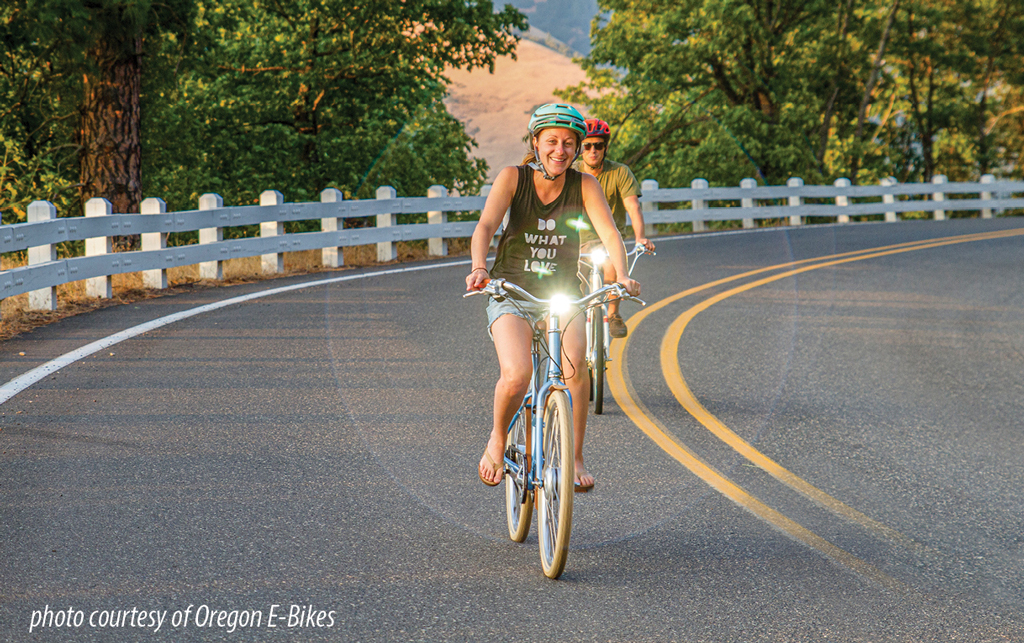

What To Know About E-Bikes
With the weather warming up, we’re beginning to see more bikes and e-bikes on the road. Hood River’s hilly terrain makes e-bikes an excellent transportation choice. E-bikes provide low-cost, energy-efficient transportation, supporting the City’s sustainable energy and multi-modal transportation goals, as well as exercise and health benefits. Though it’s positive that we’re seeing more on City streets, the Hood River Police Department has seen and received many reports of unlawful and unsafe e-bike riding.
The City of Hood River encourages e-bike users to follow State laws when riding, to help keep everyone safe. A top concern is that some operators of e-bikes are very young and may not understand the rules of the road. Here’s some information to spread to family members and friends about types of e-bikes and rules to follow on them. E-bikes, with electric assistance, must follow the same rules as traditional bikes, with some additional rules. Here’s a summary:
- E-bikes should not exceed 20mph speeds when under motorized power, and the motor should not exceed 1000w.
- Class 1 and 2 e-bikes are allowed on any roadway, lane or bike path that traditional bikes are allowed on, but are not allowed on sidewalks. Some trails prohibit e-bikes so be sure to read signs. Class 3+ e-bikes are not allowed on most shared-use paths.
- The minimum legal age to operate an e-bike is 16 years old.
- Anyone under the age of 16 riding on a highway or public area must wear protective headgear (helmet). This applies to those operating or passengers on both a traditional bike and e-bike passengers. There are exemptions if the headgear violates a religious belief or practice. .
- Riders and passengers on both traditional bicycles and e-bikes must be seated on a permanent, regular attached seat.
(Oregon laws referenced — Oregon Revised Statutes § 801.258; § 814.405; § 814.410; § 807.020; § 814.485; § 815.470)
Similar to motorcycles, electric bikes are classified into different categories based on their basic functionality.
Class 1: “Pedal-assist only” means the motor is activated only while pedaling; motor provides assistance up to 20 mph.
Class 2: In addition to pedal-assist, a throttle mechanism on the bike’s handlebars activates the electric motor (when pedaling or not), up to 20 mph.
Class 3: Pedal assist only from 20-28 mph; pedal not required under 20 mph.
Class 4: This new class of bikes aren’t considered e-bikes in Oregon — they’re motor vehicles, like a moped, and may have any combination of throttle and pedal assist modes. Class 4 e-bikes have nominal motor output above 750W and aren’t limited to any max speed. These vehicles are subject to all driving laws and require a driver license and vehicle registration (whereas operating a Class 1-3 e-bike do not).
Any class of e-bikes can go over its maximum speeds without motor use, which can easily occur going down steep hills. However, Class 1 and 2 motors shut off at 20 mph, and Class 3 motors shut off at 28 mph. Class 4 motors do not shut off.
If you’re a teenager or parent of a teen, be sure to carefully review all your local legislation and restrictions when buying an e-bike. The HRPD encourages parents to review the laws before allowing use of or purchasing an e-bike for their child. For parents with a child 16 years of age or older, please educate your child on traffic safety for e-bikes.